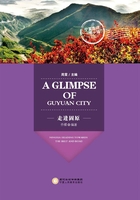
Geography
Guyuan, a prefecture-level city located in the midwest of the Loess Plateau, is in the south of Ningxia Hui Autonomous Region(henceforth Ningxia). To its north lie Zhongwei City and Wuzhong City of Ningxia, and to its east, south and west, lie Qingyang City, Pingliang City and Dingxi City of Gansu Province. The city is located at 35°14′~36°38′N,105° 20′~106°58 E. In ancient Chinese history, Guyuan was where the northern nomadic culture and the southern farming culture met, and it was an important town and fortress on the Silk Road. Being such a center among surrounding towns and cities, it boasted strategic importance in wars. The administrative seat of Guyuan is now in Yuanzhou District, which is 341 km north of Yinchuan, the capital city of Ningxia,335 km west of Lanzhou, the capital city of Gansu, and 400 km east of Xi'an, the capital city of Shaanxi. Its administrative divisions cover four counties-Xiji, Longde, Jingyuan and Pengyang, one district-Yuanzhou, 18 towns, 44 townships,3 subdistrict offices,30 community committees and 893 villagers'committees.

Guyuan is divided into two parts by the Liupan Mountains which run from north to south. The city is mostly between 1,500 and 2,200 meters above sea level, with the southern part tilting higher than the northern part. Guyuan is in the Loess Plateau hill-gully area. There are several gullies and mountains, the major mountains including the Liupan Mountains, whose highest peak, Mount Meigao(also named Mount Migang), is 2,931 meters high, the highest in Guyuan, as well as the Yueliang Mountain(2,633 meters high)and the Yunwu Mountain(2,148 meters high). Apart from the mountains, there are also hills, plains and rivers in Guyuan.
Guyuan straddles North China Craton and Qilian Craton which are divided by the Liupan fracture zone. Pengyang County, Jingyuan County and part of Yuanzhou District belong to Pingliang area which lies in Shaanxi-Gansu-Ningxia Basin area, a subdivision of North China Craton. The rest lies in Liupan Mountain area of Hexi Corridor-Liupan Mountain subdivision as well as Jingyuan-Xiji area of North Qilian subdivision. There are several characteristics of stratigraphic distribution in Pingliang area: a balanced development can be found among Lower Proterozoic Eon, Cambrian Period, Or-dovician Period, Carboniferous Period and Jurassic Period, but only a little can be seen in relict mountain or ravines because the loess has covered a large area of the region; stratum of Lower Cretaceous Period is thick and widely spread; stratum of Cenozoic Era is better developed and dispersed all over Guyuan. Strata of Liupan Mountain area are underdeveloped. There are no strata of Paleozoic Era, Triassic Period, Jurassic period, Upper Cretaceous Period or Paleogene Period. The oldest stratum in Jingyuan-Xiji area is from Lower Proterozoic Eon. Only middle and lower Devonian Series exist in the Paleozoic strategraphy. Cenozoic stratigraphy spread most widely, but there are no Paleocene Series. Most of the area is covered by loess of Quaternary Period which has formed rolling loess hills.

Because of natural influence, different geological structures and the different stages of land use from the animal husbandry to agriculture and animal husbandry and then to dry farming, different types of soil are formed in Guyuan, the major two types being dark loess soil and mountain soil. The dark loess soil, as the main soil type accounting for 66.4% of the total area, can be found in places that are of the sub-humid and semiarid type of climate. Mountain soil, accounting for 33.6%, is found in mountainous areas. It includes mountain meadow soil, mountain brunisolic soil and mountain grey cinnamonic soil. Guyuan is in the temperate continental monsoon zone with a sharp temperature difference between day and night, an annual mean temperature of 6.2 °C, an annual precipitation of 240 mm~650 mm, an annual evaporation capacity of 1,250mm~2, 000 mm, a duration of frost-free period of 97~158 days and an annual sunshine duration of 2,200~ 3,000 hours. Guyuan,especially the inner part of the Liupan Mountains, enjoys a high vegetation coverage rate and a humid climate with much rain. Therefore, it is also known as“Green Island on the Loess Plateau”.

The total land area of Guyuan is 10,500 km2, up to 17% of the total area of Ningxia. The arable land area reaches 3,930 km2, with 3,000 m2of arable land per person. The average population density is 145 people per square kilometer. Among all the counties and districts, Longde County has the highest density of 183 people per square kilometer, and Pengyang County the lowest one of 104 people.